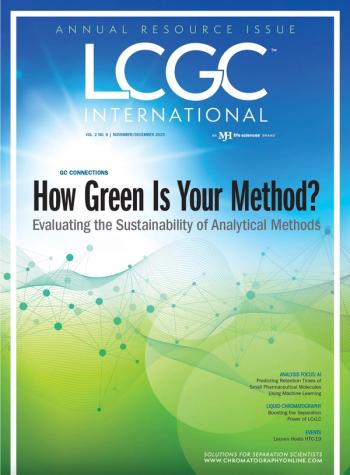
- The Column-03-06-2019
- Volume 15
- Issue 3
Investigating the Effect of Kynurenic Acid in Alcoholic Beverages
Researchers from the Medical University of Lublin, Poland, have investigated the presence of KYNA in alcoholic beverages and the significance of its presence using HPLC.
Researchers from the Medical University of Lublin, Poland, have investigated the presence of kynurenic acid (KYNA) in alcoholic beverages and the significance of its presence using high performance liquid chromatography (HPLC) (1).
A metabolite of tryptophan, KYNA has many pharmacological properties, and its potential role in human physiology is a continued topic of interest for researchers. The discovery of its neuroprotective activity sparked imaginations in the scientific world before the discovery of its inability to penetrate the blood-brain barrier scuppered hopes of a pharmacological dream (2–6). Recent research has pointed to KYNA’s interaction with receptors located on the outside of brain tissue with studies indicating anti-ulcerative (7), anti-inflammatory (8), antioxidant (9), analgesic (10), antimigraine (6), and metabolic activities (11).
The further discovery of KYNA’s presence in food and its ability to be absorbed along the digestive tract has led to the possibility that KYNA may affect other bodily processes. One such process KYNA could impact is alcohol degradation because it is known to interact with alcohol metabolism through the inhibition of aldehyde dehydrogenase activity in vivo (12). This fact is particularly pertinent because of KYNA’s presence within alcoholic beverages because it may influence alcohol degradation rate and relate to the intensity of alcohol’s negative postâconsumption attributes.
To investigate this premise, researchers used HPLC and fluorometric detection to determine the content of KYNA in a wide range of alcoholic beverages. Further tests determined the absorption and elimination rate of KYNA following beverage consumption in humans.
Researchers found KYNA in all studied beverages at varying rates with mead containing the most at 9.4 μg/100 mL and spirits containing the least at 0.01–0.1 μg/100 mL. Furthermore, it was found that KYNA was rapidly absorbed from the digestive tract with the highest blood concentration being identified 30 min after alcohol consumption. This confirmed the possibility of KYNA and alcohol interaction occurring within the human body following alcohol ingestion.
References
- M. Turska et al., Med. Hypotheses122, 200–205 (2019).
- C. Hilmas et al., J. Neurosci21, 7463–73 (2001).
- A.H. Ganong and C.W. Cotman, J. Pharmacol. Exp. Ther.236, 293–299 (1986).
- M.H. Mok et al., Neuropharmacology57, 242–249 (2009).
- S. Fukui et al., J. Neurochem56, 2007–2017 (1991).
- G. Olah et al., Drug Des. Devel. Ther.7, 981–987 (2013).
- G.B. Glavin and C. Pinsky, Res. Commun. Chem. Pathol. Pharmacol.64, 111–119 (1989).
- J. Kaszaki et al., Neurogastroentrol Motil21, 53–62 (2008).
- R. Lugo-Huitron et al., Neurotoxicol. Teratol.33, 538–547 (2011).
- F. Resta et al., Neuropharmacology108, 136–143 (2016).
- L.Z. Agudelo et al., Cell Metab.27, 378–392 (2018).
- A.A. Badawy et al., Alcohol Alcohol.46, 651–660 (2011).
Articles in this issue
almost 7 years ago
Vol 15 No 3 The Column March 2019 North American PDFalmost 7 years ago
Vol 15 No 3 The Column March 2019 Europe & Asia PDFalmost 7 years ago
Agilent Announces Thought Leader Award Winnersalmost 7 years ago
Pulse Flow Modulation for Multidimensional GCalmost 7 years ago
Knauer Wins Employer Awardalmost 7 years ago
Tuberculosis Diagnosis Using GC×GC–TOF-MSalmost 7 years ago
Pittcon 2019 PreviewNewsletter
Join the global community of analytical scientists who trust LCGC for insights on the latest techniques, trends, and expert solutions in chromatography.



